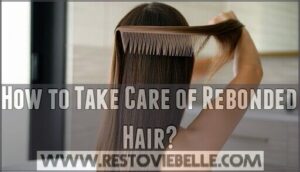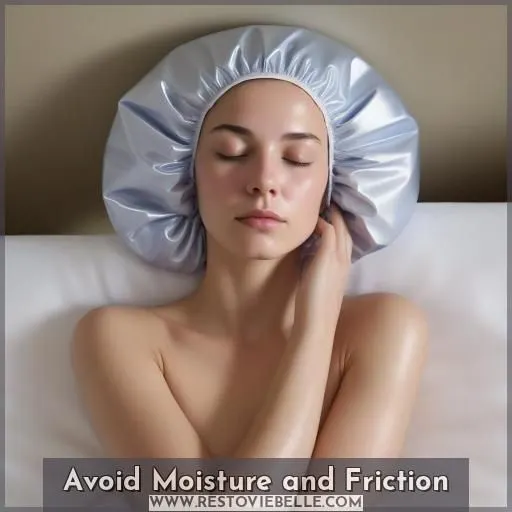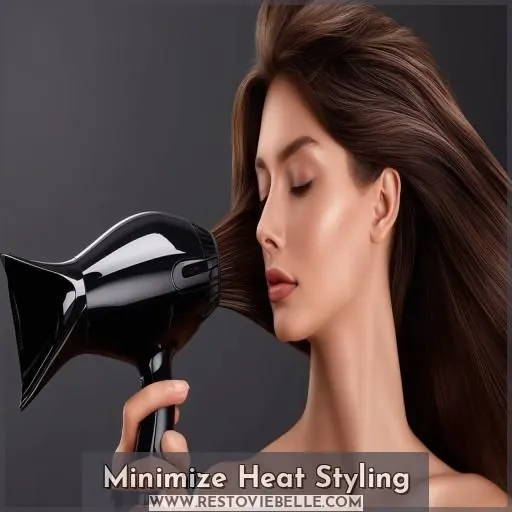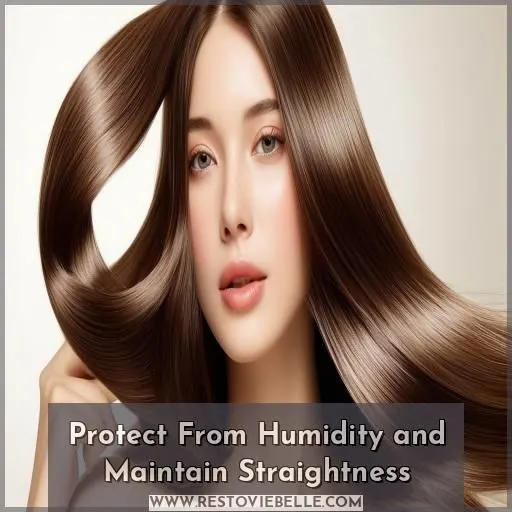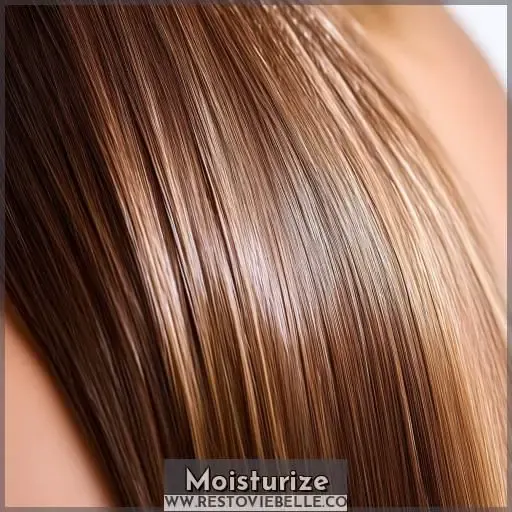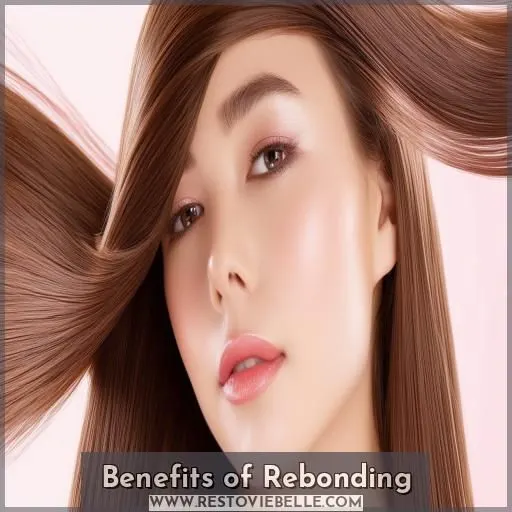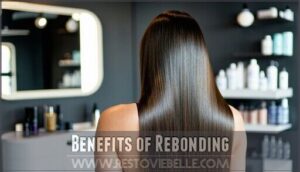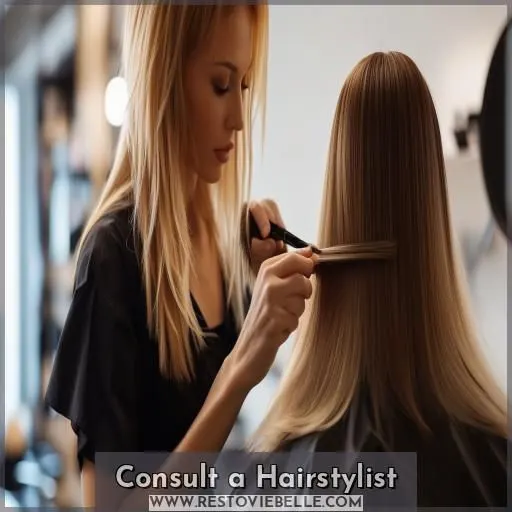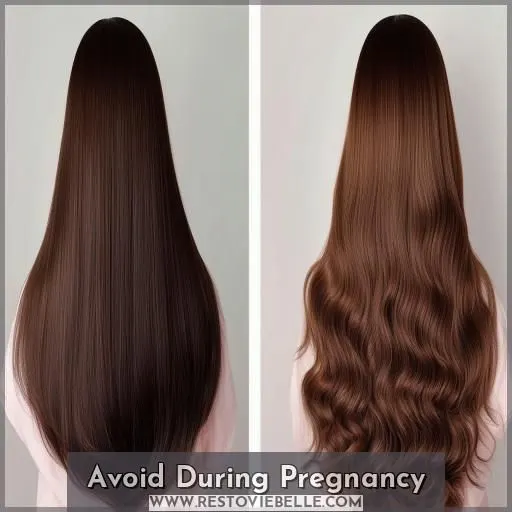This site is supported by our readers. We may earn a commission, at no cost to you, if you purchase through links.
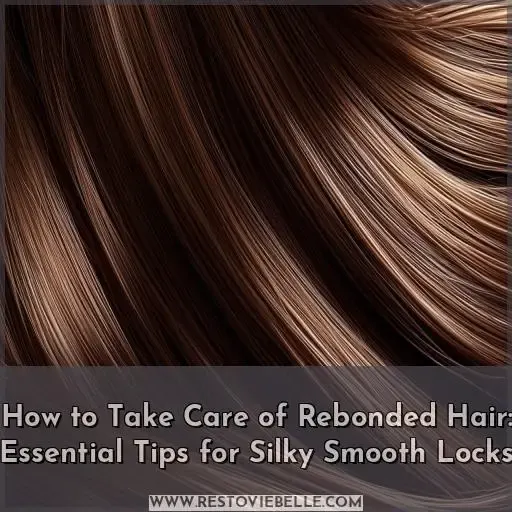 Taking care of rebonded hair requires a delicate touch.
Taking care of rebonded hair requires a delicate touch.
You’ll want to avoid moisture and friction for 72 hours post-treatment, using a wide-tooth comb and sleeping on silk pillows.
Opt for sulfate-free, gentle products infused with vitamins and keratin.
Minimize heat styling; air dry when possible and use low heat settings.
Protect from humidity with hats or scarves, and schedule touch-ups every 3-6 months.
Moisturize with coconut oil and deep conditioning masks.
With diligent care, you’ll maintain that silky smoothness rebonding provides.
Table Of Contents
- Key Takeaways
- How to Take Care of Rebonded Hair?
- Avoid Moisture and Friction
- Use Gentle Products
- Minimize Heat Styling
- Protect From Humidity and Maintain Straightness
- Moisturize
- Sleeping
- Maintenance
- Benefits of Rebonding
- Consult a Hairstylist
- Avoid During Pregnancy
- Frequently Asked Questions (FAQs)
- How long does rebonded hair last?
- Can I oil my hair after rebonding?
- What is the best hair treatment for rebonded hair?
- How to sleep with rebonded hair?
- Can hair be washed with hot water post-rebonding?
- How often should touch-ups be done for rebonded hair?
- Is it safe to apply hair dye after getting rebonding done?
- What is the recommended frequency for using hair masks?
- How long should one wait before using heat styling tools?
- Conclusion
Key Takeaways
- Maintaining sleek, rebonded locks is like taming a wild beast – it demands patience and a gentle touch. But fear not, for the rewards are oh-so-worth it!
- The first 72 hours are sacred, a period of abstinence from moisture and friction. Think of it as a rebonding detox, where your hair can fully embrace its newfound straightness without interruption.
- Gentle, sulfate-free products are your hair’s new best friends, nourishing and strengthening it with vitamins and keratin. Treat your tresses like royalty, and they’ll reign supreme in silky smoothness.
- Embrace the art of air-drying, and if heat styling can’t be avoided, proceed with caution. Low settings and heat protectants are your allies in preserving that coveted rebonded radiance.
How to Take Care of Rebonded Hair?
To take care of rebonded hair, avoid washing it for 72 hours after the treatment, use a wide-tooth comb, and apply a moisturizing conditioner every time you shampoo(Source). Minimize heat styling, protect your hair from humidity, and get regular trims to maintain the straight, frizz-free look of your rebonded hair .
Avoid Moisture and Friction
After rebonding, you’ll need to strictly follow the 72-hour rule, which means avoiding any moisture or friction that can disrupt the newly formed hair bonds. During this critical period, refrain from washing your hair, getting caught in the rain, or engaging in activities that involve excessive friction or pulling on your strands.
72. Hour Rule
To guarantee the longevity of your rebonded hair and prevent issues like hair damage and scalp irritation, strictly adhere to the 72-hour rule post-rebonding.
Through this critical period, avoid introducing moisture to your hair, as this can compromise the rebonding treatment’s effectiveness and lead to undesirable outcomes like hair loss, hair thinning, and split ends.
Embrace this rule to safeguard your hair’s health and maintain its sleek, silky texture.
Minimize Friction
To minimize friction and protect your rebonded hair, avoid using hair ties, pins, and clips.
Instead, use a wide-tooth comb or detangling spray to gently brush through your locks.
Sleep on silk pillows or wrap your hair in a soft scarf to reduce friction while you snooze.
Avoid combing wet hair, as it’s more prone to breakage.
Use a leave-in conditioner and paddle brush to tame frizz and keep your hair smooth and manageable throughout the day.
Use Gentle Products
After undergoing a rebonding treatment, it’s essential to switch to gentle, sulfate-free shampoos and conditioners that won’t strip your hair of its natural oils or cause further damage. Look for products formulated specifically for chemically treated or straight hair, containing nourishing ingredients like vitamins, keratin, or plant extracts to help strengthen and protect your newly rebonded locks.
Shampoo
After the 72-hour rule, it’s time to gently cleanse your rebonded hair.
Opt for sulfate-free shampoos to avoid stripping your hair’s natural oils. Look for shampoos infused with vitamins or keratin to nourish and strengthen your locks.
Cleansing conditioners are another great option, as they gently cleanse while providing moisture.
Apply the shampoo to your scalp and massage it in with your fingertips, then rinse thoroughly.
Avoid scrubbing vigorously, as this can cause tangles and breakage.
With the right shampoo and technique, you can keep your rebonded hair healthy and happy.
Conditioner
Conditioner is essential for rebonded hair. Use gentle, sulfate-free formulas enriched with vitamins or keratin. Cleansing conditioners are a great option for a thorough yet nourishing cleanse. Condition hair after every wash with an instant conditioner, and treat it to a deep conditioning mask once a week. For an extra boost, make a homemade conditioner with honey or eggs. Avoid heavy, silicone-based conditioners that can weigh down hair. Invest in a good leave-in conditioner or hair serum to keep rebonded locks silky smooth.
- Opt for gentle, sulfate-free conditioners
- Use deep conditioning masks weekly
- Try DIY conditioners with honey or eggs
Minimize Heat Styling
Now that you’ve learned about using gentle products and avoiding moisture, it’s time to focus on minimizing heat styling. While rebonded hair may be straight and sleek, excessive heat can lead to dryness, breakage, and undoing the effects of your treatment. Opt for air drying whenever possible, and if you must use a blow dryer, keep it on a low setting and maintain a safe distance from your hair. Limit the use of flat irons, curling irons, and straightening brushes, as they can cause significant damage over time. Consider investing in a good heat protectant spray to shield your hair from the damaging effects of high temperatures. Remember, patience is key – allowing your hair to air dry and avoiding heat styling will help maintain the health and longevity of your rebonded locks.
- Avoid heat styling whenever possible
- Use low heat settings if using a blow dryer
- Limit use of flat irons, curling irons, and straightening brushes
- Use a heat protectant spray to minimize damage
Protect From Humidity and Maintain Straightness
To maintain the straightness of your rebonded hair in humid conditions, consider the following tips to protect your sleek locks.
First, invest in hats or scarves to shield your hair from humidity and rain.
Additionally, schedule touch-ups every 3-6 months to maintain the straightness achieved through the rebonding treatment.
Finally, opt for cold showers to further protect your hair from the effects of humidity, ensuring the longevity of your rebonded hair’s sleekness and maintaining its beautiful texture.
These simple practices will help you guarantee that humidity doesn’t affect the straightness and manageability of your hair .
Moisturize
Moisturizing your rebonded hair is essential to maintain its silky smooth texture. Coconut oil is a fantastic natural moisturizer that penetrates deep into the hair shaft, providing nourishment and preventing dryness. Massage a few drops of coconut oil into your scalp and hair before bedtime, focusing on the ends. For an intensive treatment, apply a generous amount of coconut oil, cover your hair with a shower cap, and let it work its magic overnight.
- Use a deep conditioning hair mask once a week to replenish moisture and strengthen your hair.
- Steam your hair every two weeks to open up the cuticles and allow the moisture to penetrate deeply.
- Get regular trims every 6-8 weeks to remove split ends and keep your hair healthy and manageable.
Sleeping
After rebonding your hair, it’s essential to prioritize sleep protection to maintain your sleek, straight locks. Sleeping on silk or satin sheets and pillowcases can effectively reduce friction, preventing hair tangles and breakage. Avoid sleeping with wet hair, as it can lead to matting and further damage. Instead, tie your hair loosely in a low bun or use a hair cap or scarf to shield it from friction and tangles.
- Invest in quality silk or satin pillowcases for effective hair protection.
- Tie your hair in a loose bun before bed to prevent tangles and matting.
- Use a hair cap or scarf to minimize friction and keep your hair in place while you sleep.
Maintenance
To keep your rebonded hair looking its best, regular maintenance is key.
Schedule touch-ups every 3-6 months to maintain the straight, sleek look and prevent damage from new growth.
Use hair loss prevention products containing ingredients like biotin or keratin to strengthen strands and minimize shedding.
Opt for natural hair care compounds with moisturizing oils like coconut or argan to nourish and protect your locks.
Always wear a hat or scarf when going out in the sun to shield your hair from UV rays that can cause dryness and discoloration.
When brushing, be gentle and use a wide-tooth comb to detangle without pulling or breaking the hair.
With proper maintenance, you can enjoy your straight, silky rebonded hair for months to come!
Benefits of Rebonding
Rebonding offers a transformative solution for managing unruly, frizzy hair by permanently straightening and smoothing your locks through a chemical process. The lasting effects, typically between 6-7 months, deliver sleek, silky strands that are far less prone to tangles and flyaways, greatly enhancing manageability and reducing frizz.
Benefits of Rebonding
Rebonding chemically alters hair texture, transforming frizzy locks into sleek, straight strands. This permanent hair treatment reduces tangles and manageability issues, lasting 6 months with touch-ups. Enjoy smooth, silky hair with minimal effort.
Straightens Unruly Hair
Rebonding chemically alters hair bonds, effectively managing unruly hair with reduced frizz. Despite potential hair damage, the rearrangement maintains sleekness and provides control over unmanageable hair, aiding in hair loss prevention and effective hair care.
Lasts Several Months
Rebonded hair lasts 6-7 months with touch-ups every 3-6 months. Maintenance costs are higher, but you’ll enjoy sleek, straight hair suited to your texture. Steaming hair bi-weekly promotes growth and health. Wear a shower cap to protect your investment.
Reduces Frizz and Tangles
Rebonding reduces frizz and tangles, transforming unruly hair into sleek, manageable locks. Regular touch-ups maintain the straight, smooth look, but be mindful of potential hair breakage and scalp irritation. Consult a hair expert for personalized care tips.
Consult a Hairstylist
Regarding the care of your rebonded hair, consulting a hairstylist is crucial to receive individualized suggestions that fit your hair type and the timing of your consultation. Considering critical factors such as the suitability of the treatment for your specific hair type and the timing of any chemical treatment in relation to your rebonding are pivotal aspects that only a hairstylist can expertly advise on. Additionally, a reputable stylist can provide guidance on how to maintain your rebonded hair between touch-ups and preserve its health and shine. Seeking professional advice ensures that the maintenance of your rebonded locks aligns with your unique hair needs. Furthermore, for expectant mothers, discussing pregnancy safety concerns with your stylist will help you make informed decisions about whether rebonding is suitable during this time. Remember, consultation with a hairstylist is an invaluable step toward effectively managing and nurturing your rebonded hair (Source).
- Understanding the ideal timing for consultations
- Addressing safety considerations during pregnancy
- Receiving expert guidance on chemical treatments and post-rebonding care
Avoid During Pregnancy
Rebonding your hair during pregnancy isn’t recommended due to the potential risks and long-term effects.
The chemical changes involved in the rebonding process can be harsh on your hair and scalp, leading to increased damage and sensitivity. Additionally, the strong chemicals used may pose risks to your health and the developing fetus.
It’s best to consult with your hairstylist and obstetrician before considering any chemical hair treatments during pregnancy. They can provide personalized advice based on your hair type, health history, and stage of pregnancy.
If you do decide to proceed, be sure to follow all aftercare instructions carefully to minimize damage and maintain the health of your hair and scalp.
Frequently Asked Questions (FAQs)
How long does rebonded hair last?
What a beautiful rebellion against nature, you’ve chosen! Savor those sleek tresses – rebonded hair lasts around 6 months before needing touch-ups. Maintain your silky strands with diligent care.
Can I oil my hair after rebonding?
Yes, you can oil your rebonded hair after the initial 72-hour period. Use a lightweight oil like coconut or argan oil to hydrate and nourish your strands without weighing them down.
What is the best hair treatment for rebonded hair?
Coincidentally, the best hair treatment after rebonding is a protein-rich deep conditioner. It restores moisture, strengthens bonds, and prevents breakage – essential for maintaining your straight, sleek tresses.
How to sleep with rebonded hair?
Sleep on silk or satin pillowcases to minimize friction. Tie hair loosely in a low bun and cover it with a scarf overnight to prevent tangles. Avoid sleeping on wet hair, as it can lead to breakage.
Can hair be washed with hot water post-rebonding?
No, you shouldn’t wash rebonded hair with hot water initially. Hot water can disrupt the newly-formed bonds, leading to frizz and undoing the rebonding effects. Stick to lukewarm or cool water for at least a few weeks after the treatment.
How often should touch-ups be done for rebonded hair?
Like a well-tended garden, rebonded hair needs regular grooming. Touch-ups every 3-6 months help maintain that silky, straight perfection, nourishing strands and controlling frizz.
Is it safe to apply hair dye after getting rebonding done?
It’s best not to dye rebonded hair immediately. The chemicals can cause damage and breakage. Wait at least 4-6 weeks after rebonding before coloring to allow your hair to recover.
What is the recommended frequency for using hair masks?
You should use a hair mask once a week to restore moisture and nourish rebonded strands. Hair masks seal in hydration, preventing dryness and brittleness.
How long should one wait before using heat styling tools?
Over 80% of hair damage happens due to excessive heat styling. To prevent this, wait at least 72 hours before using hot tools on rebonded hair. This allows the new bonds to fully set and minimizes potential breakage.
Conclusion
Ultimately, taking care of rebonded hair requires diligence, but the silky results are worth it.
By heeding these tips on how to take care of rebonded hair – avoiding moisture, using gentle products, minimizing heat, and moisturizing – you’ll maintain those smooth, frizz-free locks for months.
With proper maintenance and care from a trusted stylist, rebonding provides a transformative solution for unruly hair.
